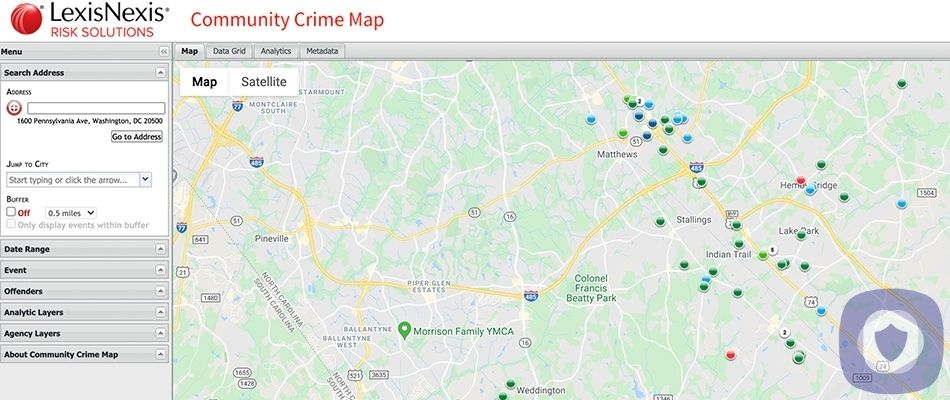The LexisNexis Community Crime Map is a unique online tool that works with local law enforcement agencies around the country to bring users accurate, timely information about crime in their areas. The website is free to use, and allows users to filter crime data by date, location, and the type of offense. Users can also sign up for crime alerts and view charts and graphs tracking trends in the types and amount of crime in their area.
The crime map can be used by law enforcement officers to determine the needs of specific areas. It’s also an excellent tool for people scoping out the best places to live in new neighborhoods, towns, and cities. The map can also help you stay informed of crime trends in your neighborhood and you can opt to be notified of new incidents quickly and accurately.
Pros
- Reliable data: LexisNexis maps crime based on police reports, so users can be sure the information is factual and up-to-date.
- Free to use: There is no cost to use the crime map or to sign up for email alerts. It’s also free for law enforcement agencies to start sharing data on the map.
- Easy to understand: The site is easy to navigate, and users have the option of viewing crime data on the map, as a list, or as a series of charts and graphs that help make sense of local crime trends.
Cons
- Every city is not represented: The LexisNexis crime map only shows data from participating law enforcement agencies, so some areas may be missing information.
- Limited to crime data: LexisNexis doesn’t offer information about local real estate trends, school quality, or amenities that may be of interest to those using the map to scout for new places to live.
Things to Consider
LexisNexis manufactures data-sharing technology that makes it easier for police departments to share information across jurisdictions. This data is retained by LexisNexis, edited to protect victim identities, and added to the Community Crime Map, which is used by law enforcement and private citizens. The data comes directly from police reports, so it is as accurate and up to date as possible. Users can also sign up for crime alerts for their area and use the site to submit anonymous tips to law enforcement.
Data on the crime map can be sorted by location, date, offenders, and the type of crime that occurred. Crimes are noted on the map using different icons, and clicking on each icon will show you more information about where and when the crime occurred, the type of crime, and the reporting law enforcement agency. You can also choose to view the data as a list, or review detailed analytics information that shows the prevalence of certain types of crimes in a specific area.
The LexisNexis Community Crime is one of our top picks for the best crime maps
At this time, the LexisNexis Community Crime Map does not show data from every police department in the country. Law enforcement agencies have to opt in to share data with the Community Crime Map. It’s free to do so, and citizens can reach out to their local Public Information Officer to request that an agency join the map.
The Community Crime Map is specifically for those keeping tabs on crime in different areas, and it doesn’t include other data about neighborhoods that new or potential residents may be looking for, like real estate trends or school data. However, for those looking specifically to track crime trends and get real time updates on crimes happening in their neighborhoods, the map is a thorough resource.
The Bottom Line
If you’re looking for accurate, easy to understand crime data that gives you peace of mind, the LexisNexis Community Crime Map is a great tool to have in your arsenal. It provides information users can trust from law enforcement agencies all over the country, and it breaks its data down by individual incident, as well as crime trends over time. The crime map is useful for law enforcement and civilians alike, and it gives users the opportunity to get real time updates and alerts or report tips to police anonymously. The LexisNexis Community Crime map helps foster communication and transparency between law enforcement and the community, and it provides people with a free tool they can use to make decisions about where to live and how best to safeguard their families.
This article has been reviewed and approved by Officer Banta.

Officer Banta is the official SecurityNerd home security and safety expert. A member of the Biloxi Police Department for over 24 years, Officer Banta reviews all articles before lending his stamp of approval. Click here for more information on Officer Banta and the rest of our team.

